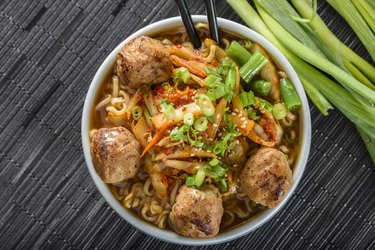
The lure of fast food and Western eating habits has affected different cultures around the world. However, the Korean diet remains largely untouched by unhealthy eating patterns.
About 30 percent of the adult population is overweight in Korea, according to the Organisation for Economic Co-operation and Development (OECD). Of those people, 4 percent have obesity, and the OECD predicts that overweight rates in Korea will increase by 5 percent within 10 years.
Video of the Day
Video of the Day
Even still, those rates are lower than they are in the United States, where over 39 percent of the adult population has obesity, according to the Centers for Disease Control and Prevention. Overall, more than two-thirds of U.S. adults have either overweight or obesity, reports the 2015-2020 Dietary Guidelines for Americans.
Given the stark contrast between Korea and the United States in the numbers of people with obesity, it's worthwhile to take a closer look at the two types of diets. Understanding the differences between typical Korean food versus American food may help you replace unhealthy foods with healthier alternatives.
Read more: Side Effects of Switching to a Healthy Diet
The Typical Korean Diet
The Korean diet traditionally includes the following foods, according to March 2016 research published in the Journal of Ethnic Foods. These foods are typically consumed at the same time:
- Bab (cooked rice) and kuk (dishes with broth)
- Kimchi (a fermented vegetable dish), served at every meal
- Banchan (side dishes), seasoned with various jang (fermented soy products), medicinal herbs and sesame or perilla oil
Kimchi, which is made by fermenting vegetables with probiotic lactic acid bacteria, offers numerous health benefits, according to January 2014 Journal of Medicinal Food research. It provides protection against cancer, obesity, constipation and signs of aging. It also promotes brain, colorectal and skin health, while boosting immunity and reducing cholesterol.
Although South Koreans enjoy their barbecue meats, they eat these foods sparingly. When making stir fry, they may use sesame oil. In addition, the Korean diet consists of a high amount of vegetables, legumes and fish, with a low amount of red meat consumed.
The food is prepared using minimal fats, primarily through fermenting, boiling, blanching, roasting, seasoning and pickling. The fermentation process is the most characteristic method, helping to enrich food flavors and preserve foods. Baking and frying are not common cooking techniques in Korea, but are more so in the United States.
The Typical American Diet
In contrast to South Korean eating habits, the American diet is often high in sugar, saturated fats and highly processed ingredients.
According to the Dietary Guidelines for Americans, most Americans exceed the recommendations for added sugars, saturated fats and sodium. In excess, these foods may cause not only obesity, but also certain cancers, diabetes, heart disease and other health problems.
Those recommended limits, per the Dietary Guidelines, are as follows:
- Less than 10 percent of calories a day from added sugars
- Less than 10 percent of calories a day from saturated fats
- Less than 2,300 milligrams of sodium a day
Additionally, more than half the U.S. population is meeting or exceeding total grain and total protein foods recommendations, while not meeting the recommendations for the subgroups within each of these food groups. Meanwhile, about three-fourths of the U.S. population has an eating pattern that is low in vegetables, fruits, dairy and healthy oils.
On top of their dietary choices, many Americans are simply consuming too many calories — causing weight gain. Your daily intake should be around 1,600 to 2,400 calories a day for adult women and 2,000 to 3,000 for adult men, the Dietary Guidelines advise. Aim for around 45 to 65 percent carbs, 25 to 35 percent fat and 10 to 30 percent protein for your daily calories.
Incorporate Korean Food
To adopt South Korean eating habits, start by replacing processed carbs and added sugars with healthier foods. Incorporate whole fruits and vegetables, lean proteins, whole grains like rice, fermented foods and minimal fats.
Instead of bacon and eggs or donuts for breakfast, try a bowl of brown rice with steamed vegetables and broiled fish. You can eat the same types of foods at breakfast, lunch and dinner if you're eating a Korean diet.
If broiled fish sounds too adventurous at 7 a.m., simply swap in healthier versions of your favorite meals at breakfast, lunch and dinner. Here are a few ideas:
- Instead of whole eggs, eat egg whites.
- Trade your highly-processed cereal for steel-cut oats sweetened with stevia or monk fruit.
- In place of hamburgers, try turkey burgers or grilled salmon.
- Rather than a side of fries, try a side salad or a broth-based soup.
- Eat more vegetables and fruits — fill half your plate with them.
Once you start adopting Korean eating habits and eliminating highly processed foods and added sugars, you'll crave unhealthy foods less and less. With time and a commitment to your health, you might find you crave your new eating habits more and more.
- Centers for Disease Control and Prevention: "Adult Obesity Facts"
- Journal of Ethnic Foods: "Korean Diet: Characteristics and Historical Background"
- Organisation for Economic Co-operation and Development: "Obesity and the Economics of Prevention: Fit not Fat - Korea Key Facts"
- Office of Disease Prevention and Health Promotion: 2015-2020 Dietary Guidelines for Americans: "Shifts Needed To Align With Healthy Eating Patterns"
- Office of Disease Prevention and Health Promotion: 2015-2020 Dietary Guidelines for Americans: "Key Elements of Healthy Eating Patterns"
- Office of Disease Prevention and Health Promotion: 2015-2020 Dietary Guidelines for Americans: "Appendix 2. Estimated Calorie Needs per Day, by Age, Sex, and Physical Activity Level"
- National Center for Biotechnology Information, U.S. National Library of Medicine: Journal of Medicinal Food: "Health Benefits of Kimchi (Korean Fermented Vegetables) as a Probiotic Food"